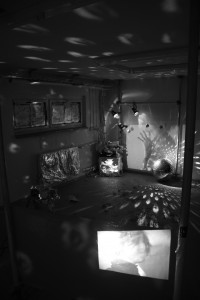 Screaming babies, dark hallways, heartbeats, water, broken TVs, shouts and singers. The first exhibition for the installation module that took place on Wednesday October 21 filled the air with a medley of different sounds that moved the visitors emotionally through the provocation of contrasting moods.
Screaming babies, dark hallways, heartbeats, water, broken TVs, shouts and singers. The first exhibition for the installation module that took place on Wednesday October 21 filled the air with a medley of different sounds that moved the visitors emotionally through the provocation of contrasting moods.
The tour consisted of eight different studios, each presenting a different environment created by a single student. The aim was to express a particular idea or feeling in an artistic way through sound engineering. With the help of lights, cloth, strings, newspapers and other materials, the students were able to submerge the guests in an alternate experience. Picture going through a door to a dimly lit room, covered with torn black fabric, and containing a human size black bag, and filled with sounds of screaming, shots, running, breathing, a shot, and then silence. Another room demanded that visitors concentrate on an ancient book while hearing the sounds of a baby crying, a toilet flushing, and voices carrying through what appeared to be very thin walls.
The exhibition had been announced at the beginning of the week to eager students and faculty who were already anticipating the event: it takes place every year as part of one of ECLA’s most popular elective courses. Wednesday’s was only the first of the four installation showings to occur this term, which means the best may well be yet to come. Future installations will focus on light, video, and the final work is expected to combine all three.
Former installation students who have had the opportunity to be involved in previous years at ECLA have stated that going through this process is a unique experience. Since the raw material comes from the students themselves, working with it to create an installation often entails a process of self-discovery which involves seeking to meet the challenge of communicating one’s ideas to others. In the module tutor David Levine’s own words: “it’s about discovering and using your own language to express something that is important to you”.
The showings, that took place from 7.30 pm to 8.30 pm, certainly triggered a great deal of nervous excitement in each of the eight students. Their work was to be exposed to the assessment of their peers. Now that this first experience has passed by, the artistically-driven students of the ECLA installation module have some exciting projects ahead. We look forward to the next exhibition, scheduled to take place in week 5.
By María Cruz (AY ’10, Argentina)
